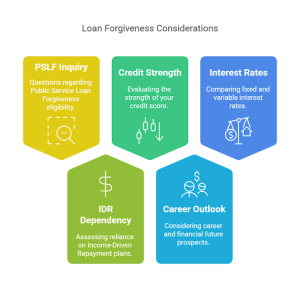Refinancing your federal student loan can seem like an attractive path to financial relief. After all, who wouldn’t want to pay less interest or reduce monthly payments? However, refinancing a federal student loan is not a decision to take lightly. There’s no going back once you move your loan from a federal servicer to a private lender. The federal protections and benefits you once had will be lost for good.
This in-depth guide will walk you through everything you should consider before refinancing your federal student loans. We’ll answer important questions: Can student loan debts be refinanced? How can you refinance student loans? Can I refinance my federal student loans? Whether you’re looking to improve your monthly budget, secure a lower interest rate, or simplify your loan obligations, here’s what you need to know before leaping.
What Does Refinancing a Federal Student Loan Mean?
Refinancing means taking out a new private loan to pay off your existing federal (or private) student loans. Essentially, a private lender buys your old loan(s). You then repay the new lender under the terms of the refinanced loan.
- Lower interest rate: If you have good credit and stable income, you may qualify for a lower interest rate. Over time, this can potentially save you thousands in interest costs.
- Different repayment terms: You might secure a shorter or longer repayment term. A shorter term typically means higher monthly payments but less interest overall; on longer terms, lower monthly payments but more interest over time.
- Consolidation: Refinancing can also help consolidate multiple loans into a single monthly payment, making your repayment process simpler—though you could also consolidate federal loans into one federal consolidation loan without losing federal benefits.
It’s essential to note that consolidation(in the federal loan context) and refinancing (through a private lender) are different. Federal consolidation keeps your loans under the federal umbrella; private refinancing moves them to a private lender.
Pros and Cons of Refinancing Federal Student Loans
Below is a closer look at the trade-offs:
Pros
- Lower Interest Rate
If you qualify, refinancing may lead to a lower fixed or variable interest rate, which can save you money in the long run. - Reduced Monthly Payments
Securing a longer-term or lower interest rate could make your monthly payments more manageable. - Simplified Repayment
Juggling multiple federal and private loans can be stressful. Refinancing consolidates them into one straightforward payment. - Potential Cosigner Release
Some private lenders allow you to refinance with a cosigner and then release them from the loan after meeting specific criteria (e.g., a series of on-time payments).
Cons
- Loss of Federal Protection
Once you refinance a federal student loan into a private loan, you lose protections like IDR plans, PSLF, and generous forbearance or deferment options. - Credit Requirements
Qualifying for a competitive refinancing rate typically requires a strong credit score and a steady income. Without these, you may not secure favorable terms. - No Undoing
You cannot revert your refinanced private loan into a federal loan if you change your mind or if policies change (e.g., new forgiveness programs). - Variable Rates Risk
Some lenders offer variable interest rates. While your initial rate may be attractive, it could spike if market conditions change.
Key Considerations Before Refinancing
Refinancing a federal student loan can be advantageous under certain conditions—but the decision largely hinges on your financial situation and plans. Here are key questions to guide your choice:
- Are You Pursuing Public Service Loan Forgiveness (PSLF)?
If you work in the public sector or plan to, you might be eligible for PSLF after making 120 qualifying monthly payments. By refinancing, you become ineligible for PSLF. Refinancing could cost you tens of thousands in loan forgiveness if you are only a few years away from this milestone. - Do You Rely on Income-Driven Repayment (IDR)?
Federal IDR plans can significantly reduce monthly payments based on your income and family size. Private loans rarely, if ever, offer such flexibility. If you anticipate fluctuations in income—or if you already rely on IDR—losing this safety net could be harmful. - How Strong is Your Credit?
Lenders evaluate your credit score, debt-to-income ratio, and employment history to determine your new interest rate. Generally, a credit score above 700 is competitive, but the higher, the better. A cosigner with excellent credit can also help. - What Are Your Career and Financial Outlooks?
Refinancing may be worth exploring if your job situation is stable and you don’t need federal forbearance or forgiveness options. However, if there’s a chance you’ll face financial hardship, they will become much more valuable. - Fixed vs. Variable Interest Rate
Private lenders may offer both fixed-rate and variable-rate loans. A fixed-rate provides consistency over time, while a variable rate may start lower but can increase unpredictably.

How the Refinancing Process Works
Refinancing your federal student loans can reduce interest costs and simplify payments, but you’ll forfeit federal benefits like income-driven repayment or PSLF.
Step 1: Shop for lenders, comparing interest rates, terms, and perks.
Step 2: Compare offers carefully, noting fixed vs. variable rates, origination fees, and borrower protections.
Step 3: Submit your application, providing personal, employment, and financial information, and consider a cosigner if needed.
Step 4: Review and sign the agreement, ensuring you understand the monthly payment, interest rate, repayment term, and the permanent loss of federal protections.
Step 5: Pay off your existing federal loans. The new lender will directly send funds to your current servicer.
Step 6: Maintain good repayment habits, such as setting up autopay and staying organized with your payment schedule.
While refinancing can save money or lower monthly costs, it’s irreversible once completed. Retaining federal status is safer if you rely on federal loan benefits or expect potential hardships. Consider your options, goals, and current financial stability before deciding. If refinancing aligns with your circumstances, these steps will help you transition smoothly. Remember, there’s no turning back once you choose to refinance, so proceed only after there’s consideration. Evaluate your credit and potential savings before taking the final step.
Top 15 U.S. Lenders for Student Loan Refinancing: Rates, Requirements, and Reviews
Disclaimer: The metrics below are for illustrative purposes only. Actual APRs, total interest savings, loan term options, and break-even periods will depend on your unique financial situation and the lender’slender’s offers.
| Lender | APR Range | Loan Term Options | Estimated TolenderTolender’srest* | Estimated Break-Even Period* | Apply Now |
|---|---|---|---|---|---|
| SoFi | 3.50% – 7.50% | 5 – 20 years | ~$5,000 – $20,000 | 12 – 18 months | Apply |
| Earnest | 3.45% – 7.80% | 5 – 20 years | ~$4,500 – $18,000 | 12 – 18 months | Apply |
| CommonBond | 3.60% – 8.00% | 5 – 20 years | ~$4,000 – $17,500 | 12 – 18 months | Apply |
| Laurel Road | 3.50% – 8.50% | 5 – 20 years | ~$4,500 – $19,000 | 12 – 18 months | Apply |
| LendKey | 3.75% – 8.25% | 5 – 20 years | ~$4,000 – $18,000 | 12 – 18 months | Apply |
| College Ave Student Loans | 3.65% – 8.00% | 5 – 20 years | ~$4,500 – $18,500 | 12 – 18 months | Apply |
| Discover Student Loans | 3.70% – 8.20% | 5 – 20 years | ~$4,000 – $17,000 | 12 – 18 months | Apply |
| Citizens Bank | 3.80% – 8.50% | 5 – 20 years | ~$4,000 – $18,000 | 12 – 18 months | Apply |
| PenFed Credit Union | 3.55% – 7.90% | 5 – 20 years | ~$5,000 – $20,000 | 12 – 18 months | Apply |
| New American Funding | 3.70% – 8.30% | 5 – 20 years | ~$4,000 – $17,500 | 12 – 18 months | Apply |
| Ascent Student Loan Refinancing | 3.70% – 8.00% | 5 – 20 years | ~$4,000 – $17,500 | 12 – 18 months | Apply |
| Waterstone Financial | 3.80% – 8.50% | 5 – 20 years | ~$4,000 – $18,000 | 12 – 18 months | Apply |
| University Federal Credit Union | 3.70% – 8.40% | 5 – 20 years | ~$4,000 – $18,000 | 12 – 18 months | Apply |
| NextGen Lending | 3.75% – 8.25% | 5 – 20 years | ~$4,000 – $17,500 | 12 – 18 months | Apply |
| Regions Bank | 3.80% – 8.50% | 5 – 20 years | ~$4,000 – $18,000 | 12 – 18 months | Apply |
Estimated Total Interest Savings: These figures represent the potential interest savings over the life of the loan compared to the current
federal loan repayment scenarios. They depend on the borrower’s rates, the refinanced rate, and the loan term.
EborroweEborrower’sreak-Even This is an approximate timeframe for when the savings on your monthly payment would recoup any refinancing
costs (such as application or origination fees).
Before moving forward with any refinancing decision, consider your financial goals, compare multiple lenders, and consult with
a financial advisor if needed.
ColenderColenders’cing a federal student loan offers potential savings through lower interest rates or reduced monthly payments. Still, it means giving up crucial federal benefits—such as income-driven repayment plans, expansive deferment options, and Public Service Loan Forgiveness opportunities. Once you refinance into a private loan, there’s to the federal system, so weigh your need for protection against any financial gain from private refinancing. Refinancing can simplify repayment and cut long-term costs if you have stable employment, strong credit, and no reliance on federal safety nets or loan forgiveness. However, if you expect to need federal safeguards or are pursuing PSLF, sticking with federal loans might be the better path. Ultimately, consider your current financial situation and plans to ensure refinancing supports your broader goals.

























